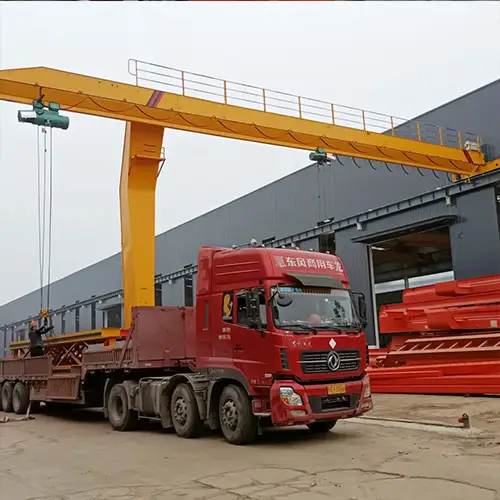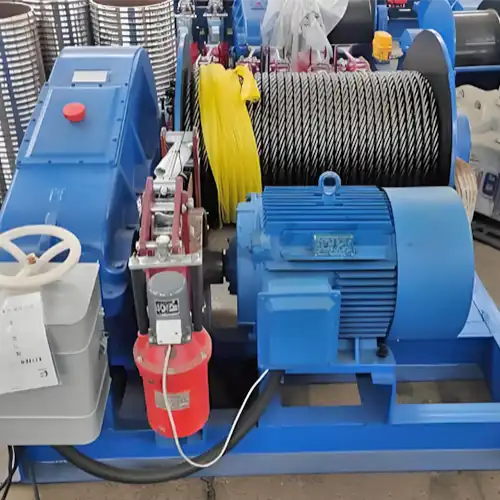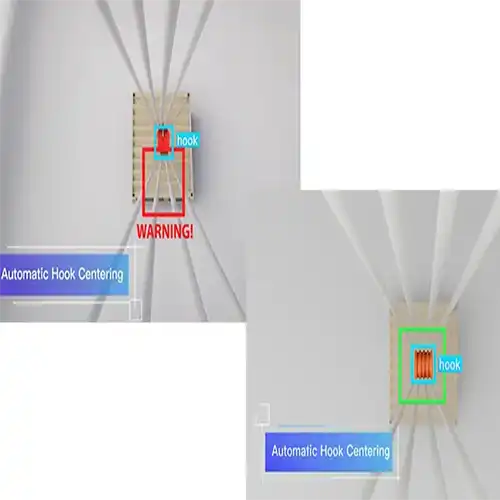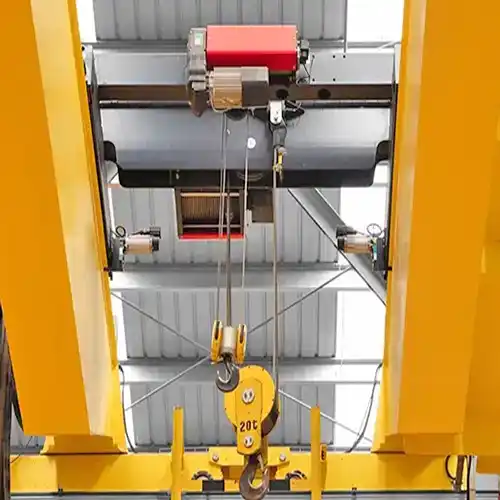Half Gantry Cranes 1 to 32 Ton, Half Cost, Custom for Your Needs
Half gantry cranes offer cost-effective, efficient material handling, tailored to your industrial use.Hot sale 3 ton, 5 ton, 10 ton, 20 ton half gantry crane.
Category: Full& Half Gantry
Your Trusted Semi Gantry Crane Manufacturer & Supplier
Half Gantry Cranes 1 to 32 Ton, Half Cost, Custom for Your Needs
Hot Sale 3 Ton, 5 Ton, 10 Ton, 20 Ton Half Gantry Crane & Single Leg Gantry Crane
Half gantry cranes offer cost-effective, efficient material handling, tailored to your industrial use.Hot sale 3 ton, 5 ton, 10 ton, 20 ton half gantry crane.
Overview of Half Gantry Cranes
Half gantry cranes, also known as semi-gantry cranes, are specialized lifting systems designed to bridge the gap between traditional gantry cranes and overhead cranes. Unlike full gantry cranes, which have two legs and run on a set of tracks, half gantry cranes have one leg that runs on a rail on the ground while the other side is supported by an overhead runway. This unique design provides a versatile and efficient solution for various lifting and material handling needs in confined spaces or where floor space optimization is critical.
Key characteristics of half gantry cranes include:
- Single Leg Support: One leg runs on a rail on the ground, while the other side is attached to a wall or an overhead runway.
- Flexibility in Installation: Can be installed in areas where full gantry cranes or overhead cranes may not be feasible.
- Wide Range of Capacities: Available in various load capacities, typically ranging from a few tons to several tens of tons, depending on the application.
- Customization: Can be tailored to specific operational needs, including span, height, and hoisting mechanisms.
A half gantry crane is a versatile lifting solution suitable for both indoor and outdoor use, commonly found in settings such as machine shops, warehouses, and freight yards. It combines features of both an overhead crane and a gantry crane: one side is mounted on an overhead runway, while the other side is supported by a leg traveling along ground-level rails.
These cranes are designed for a wide range of applications, from small to heavy-duty lifting tasks in manufacturing and material handling industries. Our company offers customizable designs to meet specific operational needs, ensuring optimal performance and efficiency tailored to your requirements.
Half gantry cranes are available in two primary configurations: single girder and double girder, each designed to meet specific lifting requirements and operational demands.
Single Girder Half Gantry Crane:
- Design and Capacity: This configuration features a single main beam and is typically equipped with electric hoists such as CD1 or MD1.
- Lifting Capacity: Suitable for lighter loads ranging from 3 tons to 20 tons.
- Work Duty: Typically rated as A4, indicating its suitability for moderate to intensive use.
Double Girder Half Gantry Crane:
- Enhanced Capacity and Efficiency: Utilizes two main girders for increased stability and lifting capacity.
- Performance: Capable of handling heavier loads compared to single girder cranes, with enhanced lifting speeds and operational efficiency.
- Work Duty: Designed for more demanding applications, often classified as A5, indicating heavy-duty use and higher performance standards.
These configurations offer flexibility in matching specific lifting needs, whether for lighter loads and moderate usage with single girder cranes or heavier loads and more intensive operations with double girder cranes. Each configuration can be tailored to optimize efficiency and productivity in various industrial environments.
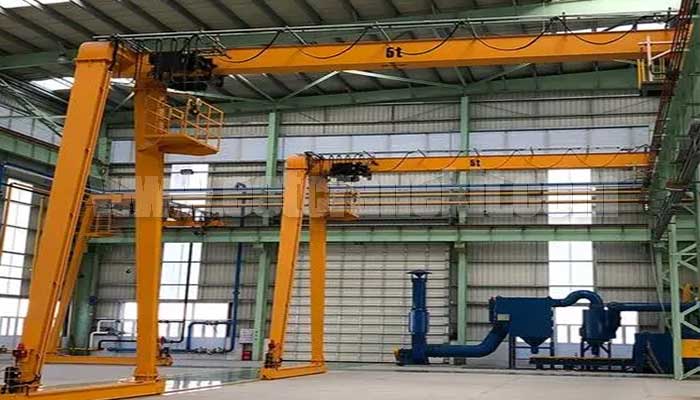
Single Girder Half Gantry Crane
BMH Single Girder Half Gantry Crane parameters:
- Load capacity: 3-20t
- Span: 8-30m
- Lifting height: 6-18m
- Lifting speed: 0.33-8m/min
- Trolley running speed: 20m/min
- Crane running speed: 20m/min
- Work duty: A3-A4
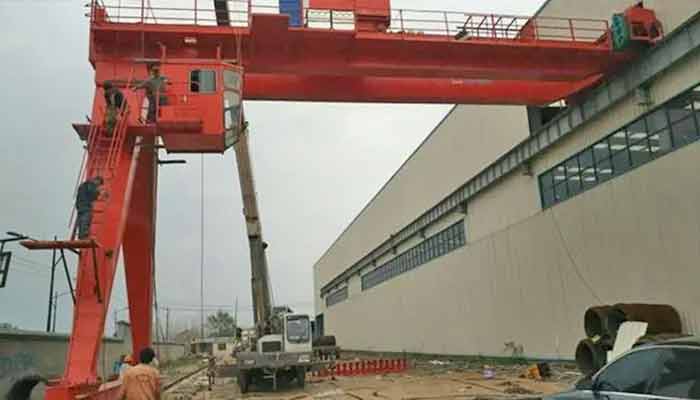
Double Girder Half Gantry Crane
BMG Double Girder Half gantry crane parameters:
- Load capacity: 5-32t
- Span: 12-30m
- Lifting height: 6-12m
- Lifting speed: 6-11.5m/min
- Trolley running speed: 37-40.1m/min
- Crane running speed: 37.7-40.1m/min
- Work duty: A3-A6
Importance and Benefits of Cost-Effective Lifting Solutions
In today's competitive industrial environment, cost-effective lifting solutions are crucial for maintaining operational efficiency and profitability. Half gantry cranes offer several economic advantages:
Reduced Material and Installation Costs:
- Lower Material Usage: With only one supporting leg and rail, half gantry cranes require less steel and structural components compared to full gantry cranes.
- Simplified Installation: The installation process is often quicker and less labor-intensive, reducing the overall cost of setup.
Lower Maintenance Expenses:
- Simplified Design: Fewer components and simpler structures mean reduced wear and tear, leading to lower maintenance costs.
- Ease of Access: Maintenance tasks are easier to perform due to the open design, minimizing downtime and service costs.
Space Efficiency:
- Optimized Floor Space: Half gantry cranes occupy less floor space, allowing for better utilization of the work area and improving workflow.
- Versatility in Layout: Suitable for installations where space constraints are a concern, such as narrow aisles or crowded work areas.
Enhanced Productivity:
- Improved Maneuverability: The single leg design provides excellent maneuverability, enabling efficient material handling in restricted spaces.
- Increased Flexibility: Can be adapted to various tasks, enhancing overall productivity and operational efficiency.
One of the standout features of half gantry cranes is their high degree of customization, making them suitable for a wide range of industrial applications. The ability to tailor these cranes to specific operational needs ensures optimal performance and maximized value. Customization options include:
- Load Capacity Variations:Adjustments to support different weight requirements, ensuring safety and reliability.
- Span and Height Adjustments:Modifications to fit the specific dimensions of the workspace, enhancing operational efficiency.
- Hoisting and Lifting Mechanisms:Selection of appropriate hoists, trolleys, and lifting devices to match the application's demands.
- Control and Automation Features:Integration of advanced control systems, including remote operation, automation, and safety features, to improve ease of use and safety.
- Special Requirements:Custom designs for unique environments, such as explosion-proof versions for hazardous areas or weather-resistant models for outdoor use.
By leveraging these customization options, industries such as manufacturing, warehousing, construction, maintenance, and port operations can significantly benefit from the adaptability and efficiency of half gantry cranes. This ensures that the lifting solutions not only meet but exceed the specific demands of diverse industrial applications.
Main Parts and Components of Half Gantry Cranes
Half gantry cranes, also known as semi-gantry cranes, are a type of crane that combines features of both overhead cranes and full gantry cranes. They are characterized by having one side supported by a leg that runs on a rail mounted on the floor, while the other side is supported by an overhead runway or attached to a building structure. This unique design allows half gantry cranes to provide efficient lifting and material handling solutions in spaces where full gantry cranes or overhead cranes may not be practical.
Single Leg Design
- Support Structure: The most defining feature of half gantry cranes is their single leg design. One side of the crane is supported by a vertical leg that moves along a rail or track installed on the floor. The other side is typically supported by an overhead runway system attached to the building structure or an independent support beam.
- Flexibility: This design allows for greater flexibility in installation and operation, especially in areas with limited floor space or where the use of two legs is not feasible.
Support Mechanisms
- Rail-Mounted Support: The single leg of the crane runs on a rail or track mounted on the floor. This rail provides stability and guides the movement of the crane along its path. The rail-mounted support mechanism is crucial for ensuring smooth and precise movement of the crane.
- Floor-Supported: In some cases, the leg may be supported directly by the floor without the need for a rail. This option is suitable for applications where floor-mounted rails are impractical or where the crane needs to move along a predetermined path on a flat surface.
- Overhead Runway: The opposite side of the crane is supported by an overhead runway, which can be attached to the building structure or supported by an independent framework. This provides additional stability and allows the crane to traverse the length of the runway.
Hoisting System
- Hoist: The hoisting system is a critical component of the half gantry crane. It consists of a hoist mechanism that lifts and lowers loads. Hoists can be electric, hydraulic, or pneumatic, depending on the application and lifting requirements.
- Trolley: The hoist is typically mounted on a trolley that moves horizontally along the crane's beam. This allows the crane to position the load accurately and efficiently along the length of the runway.
- Lifting Devices: Various lifting devices, such as hooks, slings, or magnets, can be attached to the hoist to handle different types of loads.
Control Systems
- Manual Controls: Basic half gantry cranes may be operated using manual controls, allowing the operator to control the movement of the crane and the hoisting system through levers or push buttons.
- Remote Controls: More advanced systems feature remote control operation, providing operators with the ability to control the crane from a distance. This enhances safety and allows for better visibility of the load.
- Automation and Safety Features: Modern half gantry cranes can be equipped with sophisticated control systems that include automation and safety features. These may include programmable logic controllers (PLCs), sensors, and emergency stop mechanisms to ensure safe and efficient operation.
The combination of a single leg design, versatile support mechanisms, efficient hoisting systems, and advanced control options makes half gantry cranes an adaptable and cost-effective solution for a wide range of industrial applications. By understanding the basic structure and key components of these cranes, businesses can better appreciate their potential benefits and make informed decisions about their material handling needs.
Technical Parameter of Half Gantry Cranes
| Technical Parameter of BMH Electric Hoist Half Gantry Crane | ||||||
| Capacity | t | 3 | 5 | 10 | 16 | 20 |
| Span | S(m) | 8~30 | 8~30 | 8~30 | 8~30 | 8~30 |
| Lifting height | m | 6~18 | 6~18 | 6~18 | 6~18 | 6~18 |
| Lifting speed | m/min | 8(0.8/8) | 8(0.8/8) | 7(0.7/7) | 3.5(0.35/3.5) | 3.3(0.33/3.3) |
| Trolley speed | m/min | 20(30) | 20(30) | 20(30) | 18 | 14 |
| Crane speed | m/min | 20(30) | 20(30) | 20(30) | 20(30) | 20(30) |
| Work duty | A3~A4 | A3~A4 | A3~A4 | A3~A4 | A3~A4 | |
| Track type | P24 | P24 P30 | P30 P38 | P30 P38 | P38 P43 | |
| Technical Parameter of BMG Double Girder Half Gantry Crane | ||||||
| Capacity | t | 5 | 10 | 16 | 20 | 32 |
| Span | S(m) | 12~30 | 12~30 | 12~30 | 12~30 | 12~30 |
| Lifting height | m | 6~12 | 6~12 | 6~12 | 6~12 | 6~12 |
| Lifting speed | m/min | 11.5 | 8.5 | 7.9 | 7.2 | 6 |
| Trolley speed | m/min | 37.2 | 37.4 | 40.1 | 40 | 37 |
| Crane speed | m/min | 37.7 | 37.7 | 40.1 | 40.1 | 38 |
| Work duty | A3~A6 | A3~A6 | A3~A6 | A3~A6 | A3~A6 | |
| Track type | P43 | P43 | P43 QU70 | P43 QU70 | P50 QU80 | |
Advantages of Half Gantry Cranes
Cost-EffectivenessReduced Material and Installation Costs
Lower Material Usage:
- Single Leg Structure: With only one supporting leg, half gantry cranes require fewer materials, such as steel and structural components, compared to full gantry cranes. This reduction in material usage directly translates to cost savings.
- Simpler Support Framework: The overhead runway or wall-mounted support on one side eliminates the need for a second set of rails and legs, further reducing material costs.
Simplified Installation:
- Quicker Setup: The installation process for half gantry cranes is generally quicker and less complex, leading to lower labor costs and reduced downtime.
- Minimal Structural Modifications: In many cases, existing building structures can be used to support the overhead runway, minimizing the need for extensive modifications or additional support structures.
Lower Maintenance Expenses
Simplified Design:
- Fewer Components: The single leg design and simpler structural elements mean there are fewer components that require maintenance and replacement, reducing overall maintenance expenses.
- Reduced Wear and Tear: With fewer moving parts and a streamlined design, half gantry cranes experience less wear and tear, contributing to longer service intervals and lower maintenance costs.
Ease of Access:
- Open Design: The open nature of the half gantry crane design allows for easier access to components for inspection, maintenance, and repairs, minimizing downtime and service costs.
Optimized Use of Floor Space
Minimal Floor Space Occupancy:- Single Leg Design: The single leg configuration of half gantry cranes occupies less floor space, allowing for better utilization of the available area. This is particularly beneficial in crowded or narrow workspaces where space is at a premium.
- Integrated Support: The use of an overhead runway or wall-mounted support on one side means that the crane does not need to occupy additional floor space for a second set of legs and rails.
Flexibility in Layout and Installation
Versatile Installation Options:
- Adaptability: Half gantry cranes can be installed in various configurations to suit different workspace layouts, making them adaptable to existing structures and operational requirements.
- Customization: The ability to tailor the span, height, and support mechanisms allows for flexible installation in diverse environments, from tight indoor spaces to expansive outdoor areas.
Efficient Workflow:
- Optimized Movement: The single leg design and rail-mounted support enable efficient movement of the crane along the desired path, enhancing workflow and productivity by minimizing obstructions and optimizing material handling routes.
Applications in Various Industries
Wide Range of Uses:- Manufacturing: Half gantry cranes are ideal for handling heavy machinery, components, and assembly processes in manufacturing plants.
- Warehousing: They facilitate efficient loading, unloading, and storage of goods in warehouses and distribution centers.
- Construction: Construction sites benefit from half gantry cranes for lifting and placing construction materials, equipment, and prefabricated components.
- Maintenance: Maintenance and repair facilities use half gantry cranes to lift and transport heavy parts and machinery, ensuring safe and efficient operations.
- Ports and Shipyards: In ports and shipyards, half gantry cranes handle the movement of containers, cargo, and ship components, contributing to streamlined logistics and operations.
Customizable Design to Fit Specific Needs
- Tailored Load Capacities. Varied Capacities: Half gantry cranes can be designed to handle a wide range of load capacities, from a few tons to several tens of tons, ensuring they meet the specific lifting requirements of different applications.
- Adjustable Dimensions.Span and Height Adjustments: Customization options allow for adjustments to the crane's span and height to fit the specific dimensions of the workspace, optimizing performance and efficiency.
- Hoisting and Lifting Mechanisms. Diverse Hoist Options: Depending on the application, half gantry cranes can be equipped with various hoisting mechanisms, such as electric, hydraulic, or pneumatic hoists, as well as specialized lifting devices like hooks, slings, or magnets.
- Advanced Control Systems. Automation and Safety Features: Modern half gantry cranes can be outfitted with advanced control systems, including remote operation, programmable logic controllers (PLCs), and safety features such as overload protection and emergency stop mechanisms, enhancing safety and operational efficiency.
By offering significant cost savings, space efficiency, and versatile applications, half gantry cranes present a highly effective solution for a wide range of industrial material handling needs. Their customizable design ensures that they can be tailored to meet the specific requirements of different industries, maximizing value and operational efficiency.

Customization Options
Load Capacity Variations Tailored Load Capacities:- Wide Range: Half gantry cranes can be customized to handle a diverse range of load capacities, typically from a few tons to several tens of tons. This ensures that the crane can meet the specific lifting requirements of different applications.
- Safety and Performance: By customizing the load capacity, the crane can be designed to operate safely and efficiently under the expected load conditions, preventing overloading and ensuring reliable performance.
Custom Span:
- Workspace Fit: The span of a half gantry crane can be adjusted to fit the specific dimensions of the workspace. This is particularly important for optimizing the crane's reach and ensuring that it can cover the entire operational area.
- Operational Efficiency: Customizing the span allows for better utilization of the available space, enhancing workflow and material handling efficiency.
Adjustable Height:
- Operational Needs: The height of the crane can be tailored to meet the specific operational needs, whether it involves lifting loads to significant heights or working within low-clearance areas.
- Future Flexibility: Adjustable height options provide flexibility for future changes in the workspace or operational requirements, ensuring long-term usability.
Diverse Hoisting Options:
- Electric Hoists: Suitable for most applications, offering reliable performance and ease of control.
- Hydraulic Hoists: Ideal for heavy-duty lifting, providing strong and smooth lifting capabilities.
- Pneumatic Hoists: Used in environments where electric or hydraulic power sources are impractical, offering safe and efficient lifting.
Specialized Lifting Devices:
- Hooks: Standard lifting device for general material handling.
- Slings: Useful for lifting irregularly shaped loads or multiple items at once.
- Magnets: Effective for handling ferrous materials, enhancing efficiency in metalworking and manufacturing industries.
Manual Controls:
- Basic Operation: Suitable for straightforward lifting tasks, providing direct and intuitive control over crane movements.
Remote Controls:
- Enhanced Safety: Allows operators to control the crane from a safe distance, improving safety and visibility.
- Ease of Use: Simplifies operation, especially in large or complex workspaces.
Automated Systems:
- Programmable Logic Controllers (PLCs): Enable automation of repetitive tasks, increasing efficiency and reducing the need for manual intervention.
- Integrated Sensors: Provide real-time monitoring and feedback, enhancing safety and precision in crane operations.
- Safety Features: Includes overload protection, emergency stop mechanisms, and collision avoidance systems to ensure safe operation.
Explosion-Proof Designs:
- Hazardous Environments: Customized to operate safely in environments with explosive gases, dust, or vapors, such as chemical plants, oil refineries, and mining operations.
- Certified Components: Use of certified explosion-proof components to ensure compliance with safety regulations and standards.
Weather-Resistant Features:
- Outdoor Use: Designed to withstand harsh weather conditions, including rain, snow, and extreme temperatures, making them suitable for outdoor applications such as construction sites and ports.
- Corrosion-Resistant Materials: Use of corrosion-resistant materials and protective coatings to prevent rust and degradation, ensuring long-term durability and performance.
Customization options for half gantry cranes ensure that they can be tailored to meet the specific needs and challenges of various industrial applications. By adjusting load capacities, spans, heights, hoisting mechanisms, control systems, and incorporating special requirements like explosion-proof and weather-resistant features, half gantry cranes offer versatile and efficient solutions that enhance operational efficiency and safety across diverse environments.
Industrial Applications
Manufacturing and Assembly LinesMaterial Handling:
- Efficient Workflow: Half gantry cranes facilitate the movement of raw materials, components, and finished products along the production line, ensuring a smooth and efficient workflow.
- Precision Placement: The precise control of the hoisting mechanism allows for accurate placement of parts and assemblies, which is crucial in manufacturing processes.
Assembly Support:
- Sub-Assembly Handling: Ideal for handling sub-assemblies that need to be moved between different workstations.
- Tool and Die Changes: Useful for quick and safe changes of tools and dies in manufacturing environments, reducing downtime and increasing productivity.
Customizable Designs:
- Adaptability: Can be customized to fit specific assembly line configurations and load requirements, ensuring optimal performance and efficiency.
Storage Optimization:
- Space Efficiency: Half gantry cranes optimize the use of vertical and horizontal space in warehouses, allowing for better organization and storage of goods.
- High-Rise Storage: Capable of accessing high-rise storage racks, maximizing storage capacity and efficiency.
Loading and Unloading:
- Streamlined Operations: Facilitates the quick and efficient loading and unloading of goods from trucks, reducing handling time and labor costs.
- Safety: Enhances safety during material handling operations, minimizing the risk of damage to goods and injuries to workers.
Inventory Management:
- Precise Handling: Allows for precise handling of inventory, aiding in accurate stock management and order fulfillment.
Material Movement:
- Heavy Loads: Ideal for lifting and moving heavy construction materials such as steel beams, concrete panels, and large equipment.
- Versatility: Can be used in various stages of construction, from foundation work to final assembly.
Site Flexibility:
- Mobility: Easily moved and repositioned within the construction site to adapt to changing needs and phases of the project.
- Space Efficiency: Occupies minimal floor space, making it suitable for crowded and dynamic construction environments.
Safety and Compliance:
- Robust Design: Built to withstand the rigors of construction environments, ensuring reliable performance and safety.
- Regulatory Compliance: Customizable to meet specific safety and regulatory requirements of the construction industry.
Equipment Handling:
- Heavy Machinery: Facilitates the lifting and movement of heavy machinery and equipment during maintenance and repair tasks.
- Precision: Enables precise positioning of parts and tools, enhancing the efficiency and safety of maintenance operations.
Versatile Applications:
- Wide Range: Suitable for various types of maintenance facilities, including automotive, aerospace, and industrial equipment repair shops.
- Adaptability: Customizable to fit the specific layout and requirements of different maintenance facilities.
Safety and Efficiency:
- Enhanced Safety: Reduces the risk of injury by providing safe and controlled lifting and handling of heavy components.
- Operational Efficiency: Increases the speed and efficiency of maintenance and repair tasks, minimizing downtime.
Cargo Handling:
- Container Movement: Facilitates the efficient loading and unloading of shipping containers, streamlining port operations.
- Bulk Goods: Suitable for handling bulk goods such as grain, coal, and ores, ensuring efficient material transfer.
Shipbuilding and Repairs:
- Heavy Lifts: Ideal for lifting large and heavy ship components during construction and repair processes.
- Precision Placement: Provides precise control for placing ship sections and components, critical for shipbuilding accuracy.
Environmental Adaptability:
- Weather Resistance: Designed to withstand harsh maritime environments, including exposure to saltwater, extreme temperatures, and corrosive elements.
- Robust Construction: Built to endure the demanding conditions of port and shipyard operations, ensuring long-term durability and reliability.
Half gantry cranes offer versatile and efficient lifting solutions across a wide range of industrial applications. From manufacturing and assembly lines to warehousing, construction sites, maintenance facilities, and ports, these cranes provide cost-effective, space-efficient, and customizable options to meet the specific needs of each industry. Their adaptability, combined with robust performance and safety features, makes them an invaluable asset in optimizing material handling and operational efficiency.
Cost Considerations
Initial Investment and Long-Term SavingsInitial Investment:
- Lower Material Costs: The single-leg design of half gantry cranes requires fewer materials than full gantry cranes, leading to reduced initial investment costs.
- Simplified Installation: The easier and quicker installation process lowers labor costs and minimizes downtime during setup.
Long-Term Savings:
- Reduced Maintenance Costs: With fewer components and simpler structures, half gantry cranes typically incur lower maintenance expenses. The ease of access to critical parts further reduces service time and costs.
- Energy Efficiency: Many modern half gantry cranes are designed with energy-efficient motors and systems, which can lead to significant savings in operational costs over time.
- Durability and Reliability: High-quality materials and robust design contribute to longer service life, reducing the need for frequent replacements or major repairs.
Comparison with Full Gantry Cranes and Other Lifting Solutions
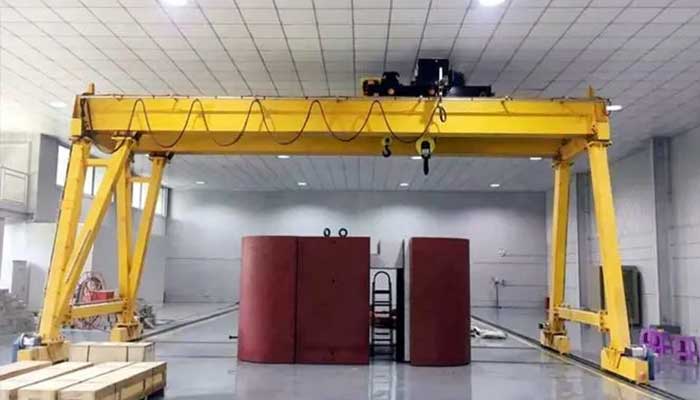
- Higher Costs: Full gantry cranes generally involve higher initial costs due to the need for additional materials (e.g., two supporting legs and extra rails) and more complex installation.
- Space Utilization: While full gantry cranes are versatile, they occupy more floor space, which may not be efficient in crowded or limited areas.
- Maintenance: The increased complexity and number of components can lead to higher maintenance and operational costs.
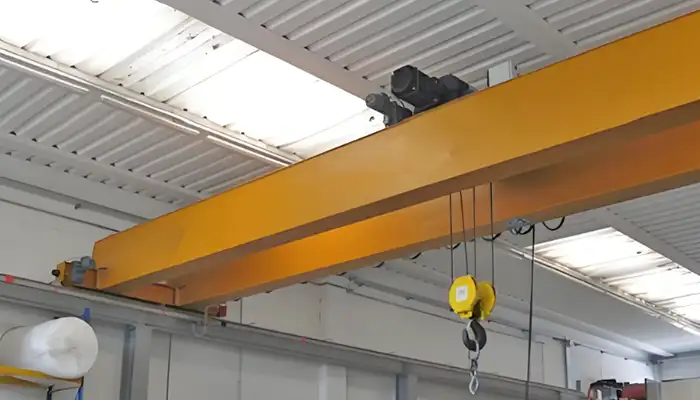
- Installation Requirements: Overhead cranes require significant structural modifications to buildings, which can increase installation costs and complexity.
- Space Efficiency: They do not occupy floor space but need sufficient headroom and robust support structures, which may not be available in all facilities.
- Maintenance Access: Maintenance can be more challenging due to the crane's elevated position, potentially increasing service costs and downtime.
Financial Benefits of Custom Designs
Optimized Performance:
- Tailored Solutions: Custom designs ensure that the crane's specifications match the exact requirements of the application, enhancing efficiency and productivity.
- Increased ROI: By optimizing performance, customized half gantry cranes contribute to a higher return on investment (ROI) through improved operational effectiveness.
Reduced Operational Costs:
- Minimized Downtime: Customization allows for features that reduce downtime, such as advanced control systems and automation, which streamline operations and minimize delays.
- Energy Savings: Energy-efficient components and systems in custom designs lead to lower energy consumption and cost savings over the crane's operational life.
Enhanced Safety and Compliance:
- Safety Features: Custom cranes can be equipped with specific safety features tailored to the operational environment, reducing the risk of accidents and associated costs.
- Regulatory Compliance: Ensuring compliance with industry standards and regulations through custom designs can prevent costly fines and legal issues.
Considering both the initial investment and long-term savings, half gantry cranes present a cost-effective solution compared to full gantry cranes and other lifting mechanisms. Their lower material and installation costs, coupled with reduced maintenance expenses and energy efficiency, contribute to significant financial benefits over time. Custom designs further enhance these advantages by optimizing performance, reducing operational costs, and ensuring safety and regulatory compliance. By carefully evaluating these cost considerations, businesses can make informed decisions that maximize value and efficiency in their material handling operations.
Selecting the Right Half Gantry Crane
Assessing Your Lifting Requirements
Determine Load Capacity:
- Weight of Loads: Identify the maximum weight of the loads that need to be lifted and transported. Consider peak loads to ensure the crane can handle the heaviest items safely.
- Frequency of Use: Evaluate how often the crane will be used, as this impacts the durability and type of hoisting mechanism required.
Evaluate Load Characteristics:
- Dimensions and Shape: Consider the dimensions and shapes of the loads. This can influence the type of lifting attachments needed, such as hooks, slings, or magnets.
- Handling Requirements: Assess whether the loads need to be rotated, tilted, or precisely positioned, which may require additional features or control mechanisms.
Identify Operational Range:
- Span and Height: Determine the required span and height of the crane to ensure it can cover the entire operational area.
- Travel Distance: Consider the distance the crane needs to travel horizontally and vertically to effectively serve the workspace.
Analyze Workspace Layout:
- Available Space: Measure the available space for installing the crane, taking into account obstructions such as columns, machinery, and other equipment.
- Floor Conditions: Assess the condition of the floor where the crane will be installed, ensuring it can support the crane's weight and movement.
Consider Installation Requirements:
- Support Structures: Evaluate existing support structures like walls or overhead beams that can be used for mounting the crane. Determine if additional supports or modifications are needed.
- Accessibility: Ensure there is sufficient access for crane installation, maintenance, and operation. This includes access for service personnel and equipment.
Plan for Future Needs:
- Scalability: Consider future expansion or changes in the workspace. Selecting a crane with adjustable or modular components can provide flexibility for future requirements.
- Adaptability: Ensure the crane can be easily adapted to new tasks or operational changes without significant modifications.
Engage with Experienced Manufacturers:
- Expert Consultation: Work with manufacturers who have experience in designing and building half gantry cranes. Their expertise can help in identifying the best solutions for your specific needs.
- Customization Capabilities: Choose manufacturers that offer customization options to tailor the crane's specifications, features, and components to your unique requirements.
Define Custom Specifications:
- Detailed Requirements: Provide detailed specifications and requirements to the manufacturer, including load capacity, span, height, and any special features needed.
- Collaboration: Collaborate closely with the manufacturer during the design and fabrication process to ensure all requirements are met and potential issues are addressed early.
Review Design and Prototypes:
- Design Verification: Review and approve design plans and prototypes to ensure they meet your operational needs and expectations.
- Testing and Validation: Ensure the crane undergoes thorough testing and validation to confirm its performance and reliability before full-scale production.
Adhere to Industry Standards:
- Regulatory Compliance: Ensure the crane design complies with relevant industry standards and regulations, such as those set by OSHA, ANSI, and ISO.
- Certification: Verify that the crane and its components are certified by recognized bodies to ensure they meet safety and quality standards.
Incorporate Safety Features:
- Safety Mechanisms: Include essential safety features such as overload protection, emergency stop systems, and fail-safe controls to enhance operational safety.
- Operator Training: Provide comprehensive training for crane operators and maintenance personnel on safe usage, emergency procedures, and routine maintenance.
Regular Inspections and Maintenance:
- Scheduled Inspections: Implement a schedule for regular inspections and maintenance to ensure the crane remains in safe and efficient working condition.
- Compliance Audits: Conduct periodic compliance audits to verify that the crane continues to meet safety and regulatory standards over its operational life.
Selecting the right half gantry crane involves a thorough assessment of your lifting requirements, evaluation of space and installation constraints, collaboration with experienced manufacturers for custom solutions, and ensuring compliance with safety and regulatory standards. By carefully considering these factors, businesses can choose a crane that meets their specific needs, enhances operational efficiency, and ensures safe and reliable performance.
Case Studies
Examples of Successful Half Gantry Crane ImplementationsCase Study 1: Automotive Manufacturing Plant
Background: An automotive manufacturing plant needed a cost-effective solution for handling heavy engine blocks and other large components in their assembly line.
Solution:
- Custom Design: A half gantry crane with a 10-ton load capacity, 8-meter span, and 5-meter height was designed to fit within the existing assembly line layout.
- Enhanced Features: Included a remote control system for precise positioning and a robust hoisting mechanism to handle the heavy loads efficiently.
Implementation:
- Installation: The crane was installed with minimal disruption to the existing operations, utilizing the plant's existing support structures.
- Training: Operators received comprehensive training on using the new crane system safely and efficiently.
Impact:
- Operational Efficiency: The crane significantly improved the speed and accuracy of handling heavy components, reducing the cycle time in the assembly process.
- Cost Savings: Lower initial and maintenance costs compared to a full gantry or overhead crane, resulting in substantial long-term savings.
Case Study 2: Warehouse and Distribution Center
Background: A large distribution center needed to optimize their material handling process for better space utilization and faster loading/unloading operations.
Solution:
- Customized Crane: A half gantry crane with a 5-ton load capacity, 12-meter span, and 6-meter height was designed to navigate the warehouse layout effectively.
- Space Efficiency: The crane's design maximized the use of vertical space, allowing for higher stacking of goods and more efficient storage.
Implementation:
- Seamless Integration: The crane was integrated into the existing warehouse management system, ensuring smooth coordination with other material handling equipment.
- Safety Features: Included advanced safety features such as load sensors and emergency stop mechanisms.
Impact:
- Improved Efficiency: The crane enabled faster and more precise handling of goods, reducing loading and unloading times.
- Enhanced Space Utilization: Improved storage capacity and organization within the warehouse, leading to better inventory management and reduced operational costs.
Case Study 3: Construction Site for High-Rise Building
Background: A construction company required a versatile lifting solution for moving heavy construction materials on a high-rise building site with limited space.
Solution:
- Versatile Design: A half gantry crane with an 8-ton load capacity, adjustable span, and height was designed to handle a variety of construction materials and adapt to different stages of the project.
- Mobility: The crane's design allowed for easy relocation within the site as needed.
Implementation:
- Rapid Deployment: The crane was quickly assembled and deployed on-site, minimizing delays in the construction schedule.
- Flexibility: The crane's mobility and adaptability proved invaluable in handling materials efficiently across different floors and areas of the construction site.
Impact:
- Operational Efficiency: Streamlined material handling processes, reducing the time and labor required for lifting and transporting materials.
- Cost Savings: Lowered equipment and labor costs due to the crane's versatility and efficiency, contributing to overall project cost savings.
Operational Efficiency:
- Speed and Precision: Half gantry cranes improve the speed and precision of material handling, leading to shorter cycle times and increased productivity.
- Workflow Optimization: Customized designs ensure that the crane fits seamlessly into the existing workflow, minimizing disruptions and enhancing overall efficiency.
Cost Savings:
- Lower Initial Costs: The reduced material and installation costs of half gantry cranes result in lower initial investments compared to full gantry or overhead cranes.
- Maintenance Savings: Simplified structures and fewer components lead to lower maintenance costs and less downtime.
- Energy Efficiency: Energy-efficient designs reduce operational costs over the crane's lifetime.
- Long-Term Durability: High-quality materials and robust construction enhance the crane's durability, reducing the need for frequent replacements and major repairs.
These case studies highlight the successful implementation of half gantry cranes in various industries, demonstrating their impact on operational efficiency and cost savings. By tailoring the crane design to specific needs and optimizing their features for the given environment, businesses can achieve significant improvements in productivity and financial performance.
Double girder semi gantry crane and half gantry crane 1 ton to 16 ton
Double girder semi gantry crane and half gantry crane3 ton to 32 ton
Half gantry crane with L shape gantry frame
Conclusion
Half gantry cranes offer a myriad of advantages that make them an excellent choice for diverse industrial applications:
Cost-Effectiveness:
- Lower Initial Investment: Reduced material and installation costs compared to full gantry cranes and overhead cranes.
- Long-Term Savings: Lower maintenance expenses, energy efficiency, and robust design contribute to significant savings over the crane's lifespan.
Space Efficiency:
- Optimized Use of Space: The single-leg design allows for more efficient use of floor space, which is crucial in crowded or space-limited environments.
- Flexible Layout: Adaptability to various workspace configurations without major structural modifications.
Versatility:
- Wide Range of Applications: Suitable for manufacturing, warehousing, construction, maintenance, ports, and more.
- Customizable Features: Tailored designs to meet specific operational needs, enhancing productivity and operational efficiency.
Enhanced Operational Efficiency:
- Precision Handling: Advanced control systems and customizable hoisting mechanisms allow for precise load handling.
- Improved Workflow: Streamlined material handling processes lead to increased productivity and reduced cycle times.
Customization is a critical factor in maximizing the value of half gantry cranes. By working closely with experienced manufacturers to tailor the crane's design and features to specific operational requirements, businesses can achieve:
Optimal Performance:
- Matching Specifications: Ensuring the crane meets the exact load, span, and height requirements for the intended application.
- Incorporating Advanced Features: Adding necessary features such as remote controls, safety mechanisms, and automation to enhance performance and safety.
Increased Flexibility:
- Adaptability: Custom designs can be easily adapted to changing operational needs, providing long-term flexibility and scalability.
- Future-Proofing: Planning for future requirements and potential expansions, ensuring the crane remains valuable as business needs evolve.
Enhanced Safety and Compliance:
- Safety Enhancements: Including specific safety features tailored to the operational environment, reducing the risk of accidents.
- Regulatory Adherence: Ensuring the crane design complies with industry standards and regulations, avoiding fines and legal issues.
As industries continue to seek cost-effective and efficient lifting solutions, half gantry cranes are poised to play a significant role. The growing demand for customizable, space-efficient, and versatile material handling equipment will drive further innovations and advancements in half gantry crane design and technology.
Technological Advancements:
- Automation and IoT Integration: The integration of automation and Internet of Things (IoT) technologies will enhance crane performance, enable predictive maintenance, and improve safety.
- Sustainable Solutions: The development of energy-efficient and environmentally friendly crane designs will align with the increasing focus on sustainability in industrial operations.
Expanded Applications:
- New Industries: The adaptability of half gantry cranes will see their adoption in new industries and applications, including renewable energy, advanced manufacturing, and smart warehouses.
- Customized Solutions: The trend towards highly customized material handling solutions will continue, with manufacturers offering more tailored options to meet specific industry needs.
Half gantry cranes provide significant benefits in terms of cost-effectiveness, space efficiency, versatility, and operational efficiency. Customization plays a crucial role in maximizing these benefits, ensuring that the crane meets specific operational needs and delivers long-term value. As technology advances and industries evolve, half gantry cranes will continue to be an essential component of cost-effective lifting solutions, driving productivity and efficiency across various sectors.
Related Products

Latest project
150 Ton Overhead Crane Installation Feedback – Paraguay Case
QDX 150 ton overhead crane in action in Paraguay. Installation photos, video, and client feedback show performance, safety, and heavy-lifting efficiency.
Free consultation to Confirm Parameters & Specifications and Get
Latest Crane Price & Crane Rate.
- Types of overhead cranes : _______?
- Optional: Overhead travelling crane, goliath gantry crane,Slewing jib crane, Single girder or double girder crane,small portable crane or kbk crane, etc.
- Capacity of overhead crane: _______?
- Optional: 0.25ton, 0.5 ton, 1 ton, 2 ton, 3ton, 5 ton, 10 ton,15ton, 20ton, 25 ton, 30ton,35ton, up to 550ton, etc.
- Crane span & lifting height : _______?
- Crane travelling length : _____?
- Control of overhead crane:_______?
- Optional: pendant/ remote/cabin control
- Voltage supply of overhead crane:_____?
- Eg,: 380V50/60HZ,3Phase or others,etc.
- Application/usage of crane:_______?
- Eg,: Steel mill, ,injection mold, cement,stone, concrete,granite, general manufacturing, etc.
Just leave a message via the contact form and our hoist and crane engineer will contact you with in 24working hours.
Get In Touch
